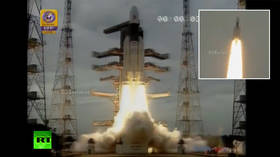India successfully launches Chandrayaan 2 rover mission to Moon’s South Pole (VIDEO)

India’s space agency has successfully launched a lunar mission after the first was rescheduled due to a technical glitch. It is set to land on the Moon’s South Pole in the hope of making some groundbreaking discoveries.
Chandrayaan-2 lifted off on Monday at the Satish Dhawan Space Center, located several miles inland from the Bay of Bengal. The Indian Space Research Organisation (ISRO) used its 640-ton GSLV Mark-III rocket for the mission.
A round of applause was heard at the mission control room shortly after the launch, with scientists and engineers watching the rocket take off towards orbit. A short while later, the agency reported that the launch vehicle successfully brought the spacecraft into the outer atmosphere, meaning that India’s most complex mission in space had just begun.
The second attempt to launch the Chandrayaan-2 into orbit came a week after the first try saw the countdown being stopped less than an hour before the mission’s departure. At the time, a "technical snag was observed in [the] launch vehicle system", according to ISRO.
Chandrayaan-2 includes four key components, the rocket, an orbiter, lander, and the small rover. Indian scientists hope that the mission reaches the Moon on 48th day of space travel when the lander is expected to drop from the orbiter.
— ISRO (@isro) 22 июля 2019 г.
After it touches down on the Moon’s surface, a small solar-powered rover will be deployed. It is set to make its first movements in early September. The mission has been scheduled for the beginning of a lunar day to allow the Pragyan (wisdom in Sanskrit) rover to get as much sunlight as possible.
Also on rt.com Who ‘owns’ the Moon 50 years after mankind’s 1st ‘giant leap’During its 14-day lifetime, Pragyan is expected to travel half a kilometer from the lander and snap images to send back to Earth.
India is striving to become the fourth country, after the US, USSR, and China, to land on the Moon. That aside, Chandrayaan-2 stands out from other missions as it will land at the little-explored South Pole. It will try to gather data on the lunar surface, searching for water and minerals. Among other things, the mission is tasked with recording and measuring moonquakes.
Think your friends would be interested? Share this story!














